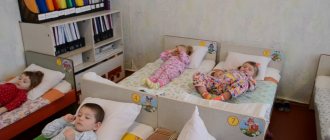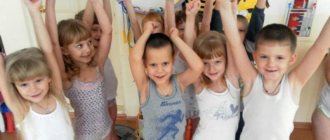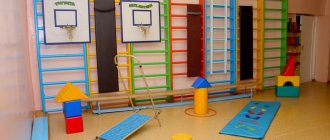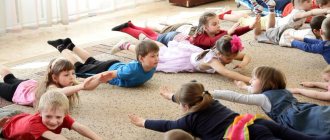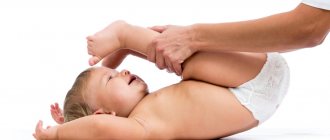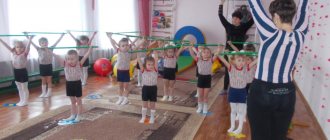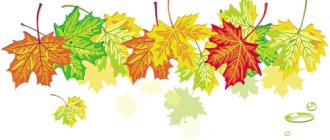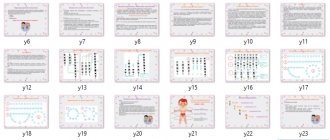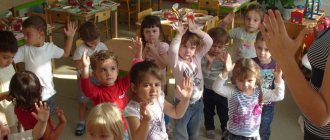Gymnastics for children 4-6 months
Unconditioned reflexes gradually fade away, so the proportion of passive-active exercises increases. The number of repetitions of the same exercise also increases.
Passive exercises are performed - flexion and extension in large joints.
Circular movements in the hip joints, with the obligatory fixation of the child’s knees with your own hands.
Simultaneous flexion - extension of the legs.
Starting position: on your back. You should grab the child's legs at the bottom of the lower leg from behind, holding the feet. Bend your legs at all joints, pressing them lightly towards your stomach (the baby's knees should be spread apart), then straighten the baby's legs.
Connection of opposite and identical knee-elbow.
The range of exercises on the ball is expanding.
At this age, many children swing with interest on the ball while lifting the toy from the surface.
On the ball in a position on the back, you can rock the baby with a slight “squat” when the legs reach support.
From 5 months, you can rock the baby on its side, pushing off the support surface.
Gymnastics for children 6-9 months
In addition to the exercises already described:
Breathing exercises are done on your back, on your side, or start while sitting.
Simultaneous and alternate abduction of the arms to the sides, upwards, grasping movements with the arms.
All exercises for the legs are performed: “stomps”, sliding steps, circular movements of the legs, alternating flexion and extension.
A new exercise is introduced: cycling.
Starting position: on your back. With the child's legs bent at the hip and knee joints, circular movements are performed, reminiscent of the movement of the legs while riding a bicycle.
In a sitting position (in a tailor's position, when the feet are joined or in a Turkish position), the child is rocked using a toy and encouraged to stretch after it.
Try in every possible way to encourage your baby to actively turn from back to stomach and back.
An exercise aimed at developing crawling skills is useful. During this period of time, you can help the child by substituting your palm as a support.
Exercises are performed to develop walking: stepping from foot to foot is stimulated, while the adult first supports the child’s armpits, and subsequently, the hands of both hands.
In exercises on the ball: you can use swinging on it in a sitting position.
How to analyze such gymnastics
Like any other structural element of the educational process, invigorating gymnastics requires careful analysis. The purpose of such monitoring is to draw up an overall picture of the effectiveness of measures aimed at promoting the health and general development of children; the analysis allows us to understand whether additional adjustments are needed in the teacher’s approach to this issue. The analysis is carried out once every 2–4 weeks as new complexes are introduced. At the beginning, general information is indicated:
- name of the preschool institution and group,
- teacher's name,
- date of gymnastics,
- children's age,
- number of children in the group.
Awakening gymnastics is part of the work aimed at preserving and strengthening the health of children
Table: sample analysis scheme for invigorating gymnastics
| No. | Gymnastics stage | List and description of exercises | Time frame | Conclusion (were the goals achieved or not, did they meet the allotted time, did all the children succeed) | Notes |
| 1 | Start of the climb, toilet | 3 minutes | Conclusion | (At the discretion of the teacher) | |
| 2 | Exercises in bed | (List specifically and describe) | Conclusion | (At the discretion of the teacher) | |
| 3 | Exercises near the bed (including walking on massage mats) | (List specifically and describe) | 1–2 minutes | Conclusion | (At the discretion of the teacher) |
| 4 | Outdoor game | (List specifically and describe) | 2 minutes | Conclusion | (At the discretion of the teacher) |
Daytime naps help children aged 1.5 to 3 years old regain strength after various types of activity, and also allow them to get used to their new life in kindergarten. Methodically well-constructed invigorating gymnastics allows you to carefully integrate it into the general daily routine, which is necessary for the harmonious organization of the pedagogical process.
Time plan
To maintain a positive attitude, invigorating gymnastics must fit within a certain time frame. For children 1.5–3 years old, the distribution of time for each stage of work will be as follows:
- exercises in cribs - 2-3 minutes,
- exercises near the cribs (including walking on massage mats) – 1–2 minutes,
- outdoor game - 2 minutes.
Small children have difficulty waking up, so more time is allocated for exercise in their cribs. At the same time, the increase in the number of minutes occurs due to a slowdown in the pace of task completion, and not an increase in the number of loads.
Example: summary of invigorating gymnastics in the first junior group (fragment), author Olga Burakova, teacher of the preschool educational institution “Kantemirovsky kindergarten No. 1”
